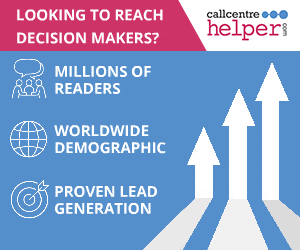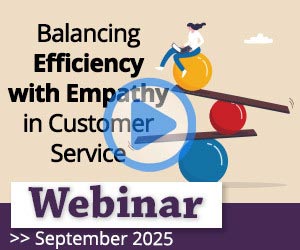According to the latest Call Centre Helper research, email makes up 16% of the average contact centre’s volume.
Yet not everyone is wowing customers on this channel.
To find out how to make every email interaction count, we asked Leslie O’Flahavan, Principal and Owner at E-WRITE, to share three tips that can help you write better emails to customers.
Video: The Secrets to Writing Better Customer Emails
Watch the video below to hear Leslie explain three tips to help you improve the emails you send to customers:
With thanks to Leslie O’Flahavan, Principal and Owner at E-WRITE, for contributing to this video
Three Tips for Writing Better Email Responses
Here are three practical tips for improving your email responses:
1. Always Customize the Template
If you’re using templates, macros, or pre-written responses, never rely solely on them. It’s crucial to customize and personalize each response.
While templates can save time, customers deserve a message that feels personal and relevant. You don’t need to rewrite the entire response, but blending pre-written content with some fresh, original text makes all the difference.
“Always customise the template. If you’re working with macros, templates, pre-written answers, form letters, whatever you call them – always customise them.
Your customers won’t mind at all, and they won’t notice that some of your response is pre-written, if some of your response is not pre-written.
So you must mix what you have, in the knowledge base or in your CMS, you must mix what you have there with fresh writing.
Customers deserve free text or fresh writing, and they will trust your answer better if it includes something that they can recognize is you have written to them only.
For example, pulling information from your knowledge base or CMS is fine, but be sure to add a few lines that specifically address the customer’s situation.
If you do this, customers are less likely to notice that part of the response is standard. Instead, they’ll appreciate that the message is directed toward them and their unique issue.
This builds trust, making customers feel like they’re being heard, rather than just receiving a generic response. A simple sentence or two that acknowledges their specific concerns can go a long way in establishing a more authentic connection.
2. Be Prepared to Express Empathy and Sympathy
Saying “sorry” is important when something goes wrong, but showing empathy is just as crucial. Sympathy is when you apologize and acknowledge the problem.
Empathy goes a step further – it shows that you understand how the problem affects the customer personally.
“Be prepared to express empathy as well as sympathy. Develop your repertoire for the kind of writing that connects with customers emotionally.
Most of us are well prepared to apologize when our company has done something wrong, or when the customer has a strong and legitimate feeling of disappointment, we say we’re sorry.
When our website isn’t working properly, we say we’re sorry. When the customer purchased a product and when it arrived it was shattered, we say we’re sorry.
That we’re well prepared to do, but I want you to build your skills and empathise using language that shows I understand your perspective, or I understand the steps you have taken to solve this problem.”
For example, if a customer says a product arrived broken, it’s not enough to just say “We’re sorry.” You should also show that you understand their frustration by saying something like “I can imagine how disappointing it must be to receive a broken product after waiting for it.”
This extra effort shows you really understand what they’re going through. Think of it as like using both your right and left hands, as Leslie explains:
“It’s like being ambidextrous in a way, if you’re right handed, you have a strong right hand and you can, catch, throw, draw, and write with your right hand, but develop those left hand, left arm muscles as well.
There’s not just one flavour of emotional connection there should be two – both sympathy and empathy.”
But if you practise and build strength in your left hand, it will improve too. Similarly, most of us are strong at expressing sympathy, but we need to develop our “left hand” skill of empathy.
There isn’t just one way to connect emotionally with customers; using both sympathy and empathy creates a much more powerful connection.
3. Mirror the Customer’s Words
One of the most effective ways to build trust with your customer is to use their own words in your response.
“Mine, or scour, or dig through the email the customer wrote to you, so you can use some of their wording in response. This can be almost a bit of a show-offy writing behaviour, but it’s a very good one because it helps convince customers that you read their email.“
This technique shows that you’ve read their email carefully and are fully engaged with what they’ve said, and it also reassures them that your reply isn’t just a standard response.
For example, if a customer writes, “We were so disappointed that you delayed our flight by three hours because we were travelling to our niece’s college graduation and we missed it,” make sure your response mentions the niece, the graduation, and the disappointment.
Saying something like “I’m really sorry you missed your niece’s graduation because of the delay” makes the customer feel heard and understood. This technique doesn’t take much extra effort, but it’s a powerful way to connect on a personal level.
By mirroring their language, you show that you’ve taken the time to fully understand their concern, which helps build trust. It also makes the customer more likely to follow through with any instructions you provide, such as submitting a claim form, as Leslie continues:
“It’s not extra work really, if you’re free texting or customizing your response, and when you use their own words, you connect with them in a way that will build trust, and on their part, acceptance and even obedience.
If the process you’re telling them to do is submit a claim form online, you want them to do it after you tell them to do it once, but they need to trust you. In one way you can build that trust is to use their words in your response.”
This strategy is not only about solving the problem but also about making the customer feel valued and important.
If you are looking for more great insights from the experts, check out these next:
- The Pros and Cons of Agent Self-Evaluation
- What’s the Best Sample Size for Quality Scoring?
- How to Use the 3 Strike Rule in the Contact Centre
- How to Use the Sandwich Technique for Customer Service
Author: Robyn Coppell
Reviewed by: Hannah Swankie
Published On: 22nd Oct 2024 - Last modified: 12th Jun 2025
Read more about - Video, Email, Leslie O'Flahavan, Soft Skills, Top Story, Videos


















